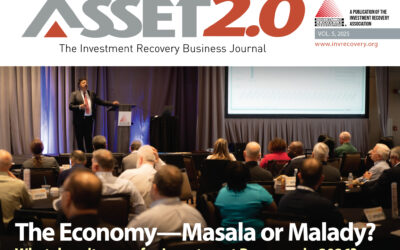What do you do with outdated or used equipment and industrial components, or other surplus assets that are unlikely to add value over time? This surplus inventory may be taking up your valuable space that could be put to better use or you may want to recoup your invested funds. Here, investment recovery or asset recovery can offer a perfect solution. In this comprehensive guide, we will discuss all you need to know about investment recovery.
So, let us dive in.
What Is Investment Recovery
Consider this. As a business, you may have acquired items or assets based on your project needs or requirements. However, there may be instances when the technology becomes outdated, requirements shift, or the project gets scrapped. This means that the assets which were once useful are now redundant or unused.
Investment or asset recovery is the method of reclaiming the invested funds from these redundant or surplus assets. This can be achieved by reusing, recycling, selling, or disposing of them. So, when you set up an investment recovery plan, you transform the assets that are no longer required for your business into liquid capital. This way you not only free up space for new assets but also reduce costs associated with storing or protecting redundant assets.
What Is an Investment Recovery Plan
An investment recovery plan or program can be defined as a strategic initiative comprising projects and actions aimed at achieving critical business goals—closures, sales, transfers, appraisals, waste stream management, or demolition. These plans can be both centralized or decentralized and designed per the strategic objectives, defining the scope for assets such as machinery, vehicles, office furniture, and MRO (maintenance, repair, and operations) supplies.
Do You Need to Adopt Investment Recovery
In the modern business landscape, both large and small organizations practice some form of investment recovery. With that being said, it brings more benefits to larger organizations as they typically have a higher number of unused assets, providing them with more opportunities to generate significant savings.
Investment Recovery: Benefits for Your Business
Here’s a quick look at the different ways an effective investment recovery plan can help your business.
Recover capital
When you implement an investment recovery strategy, the bottom line is to recover capital. This usually involves generating capital through the sale of surplus assets. By liquidating unused assets, not only does the cash flow improve but it can be redirected to meet the current needs of your business.
Support sustainability
Corporate sustainability has become the buzzword and a successful asset recovery plan can be a positive step towards it. When it comes to investors, corporate sustainability makes your business appealing for future investments. And for your company, achieving sustainability goals can help avoid costly pitfalls.
Get more space
Without a doubt, storage spaces are getting costlier. When you retain surplus assets, expenses for additional storage are a huge consequence. Liquidating these unused industrial assets can free up storage space which can be used for more cost-effective uses.
Gain environmental benefits
When you repurpose or resell your surplus items or assets to someone who can use them, you are essentially playing a role in preventing these items from getting to scrap yards to landfills. This not only supports the environment but also establishes your image as a business that is socially and environmentally responsible.
Reduce inventory
Adopting an asset recovery plan can also help you avoid slow-moving or stagnant inventory. With the investment recovery process, businesses not only recoup value but also clear out storage space, optimizing inventory for more essential assets.
What All Can You Recover to Generate Value
Although every business is unique, there are a number of items that can be recovered to generate value. Here’s a quick look at some of the common categories.
- IT assets
- Process equipment
- Production equipment
- Testing/measurement equipment
- Material handling equipment
- Maintenance shop equipment
- MRO
- Spare parts inventory
- Vehicles
- Rolling stock, etc.
Have Surplus Assets: Ways to Identify Them
For many organizations, identifying surplus assets can be challenging—especially, if the assets are managed by another person, group, or department, or are located in different regions. In other cases, the group may not feel motivated to classify the assets as idle.
When identifying any asset, gather information including manufacturer, serial number, model number, etc. At this point, it is also important to assess the condition of the asset using the defined process or steps.
Here are some signs to help you identify surplus assets.
Sign 1: Slow-moving inventory
Look for slow-moving items (slow turnover rate) in your inventory. For instance, if your business operations require equipment every three years but you already have it in stock and more are scheduled for purchase, then it means you have a surplus. Identifying such additional assets in your inventory can help you in avoiding stockpiling and optimizing resources.
Sign 2: Warehouse storage
Are you well aware of your current storage needs? Ideally, if you are running efficient business operations and not accumulating any surplus inventory, there is no need for additional storage—unless you have a new product line or project launch. Additional storage spaces, thus, can also be an indication of a surplus.
Sign 3: Purchase history/ finance records
A good starting point to check for surplus items is your company’s financial records. For instance, you can go through the history of equipment or MRO purchases and examine the expense reports to identify items that might qualify for tax write-downs.
Effective Investment Recovery Methods
After you have identified surplus assets, the next step is to choose the best method to recoup their value. Here are some methods used by investment recovery professionals with their pros and cons to help you make the right choice.
Redeployment
Redeployment means using idle or used assets in a different part of the organization without any modifications. In this method, the otherwise surplus assets are put back into productive usage, avoiding the need to buy new items and saving money. However, with redeployment, businesses should consider the following:
- Need for the asset in another department/operation
- Feasibility of transferring it to the desired location
- The benefit of reuse over the cost of acquiring new items
Pros
- Immediate reuse
- Productive usage in a similar or different operation, production line, or location
Cons
- Equipment breakdown
- Additional time or costs for repair
Refurbishment/recondition
Refurbishing or refreshing involves used equipment or MRO supplies being reintroduced into the production line for new or original purposes. Usually, the reconditioning of existing industrial assets is more cost-effective than buying a new one.
Pros
- Familiarity with equipment ensuring ease of use
- Less expensive than buying new items at current market rates
Cons
- Difficulty in integration with new tools or technologies
- May limit modernization/ advancement
Resale
In this method, the owner of the surplus asset may choose to sell it through various means, in the form of forced or orderly liquidation. These methods can include online auctions, consignments, private treaty sales, and others.
Pros
- Boosts cash flow due to the generated revenue
- Helps reclaim used storage space for other critical assets
Cons
- Costly and complex process
- Requires a dedicated individual or team who can ensure maximum return for the sale
Let us explore common reselling options used by investment recovery professionals.
- Private treaty sale: This sale method is primarily used for sensitive or branded assets wherein the owner doesn’t want to make it publicly available. The investment recovery professionals may sell the asset to a broker or a select group of buyers, often with additional terms due to the sensitive nature of assets.
- Fixed price sale: This is quite a straightforward method in which the item or asset is listed at a fixed price. If the buyer agrees with the price, the purchase is closed.
- Auction: Auction can be offline or online and is a cost-effective way to sell assets through competitive bidding. It works well in cases where there are multiple buyers or the asset’s value is not known.
- Sealed bid: As the name suggests, it is similar to auction (bidding). However, in this case, the last and best offer is accepted. It ensures a fair process but when compared to regular auctions, it lacks the dynamic price discovery.
- Consignment: In this method, the assets are consigned to a third party who are experts in sales to qualified buyers. This saves time but sellers may have to pay additional fees to consignment companies.
Donation
Donating surplus assets or equipment is not a very common practice but still can reap many benefits. It may take more time to find a ‘willing’ and ‘worthy’ recipient and may involve record-keeping and understanding of tax implications. Despite this, it is still a valuable recovery method that can balance business considerations with support and engagement.
Pros
- Supports recipient organizations
- May offer some tax benefits
Cons
- Some assets may not qualify for benefits or the benefits may be minimal
Disposal
Disposal can be an effective method for certain types of assets—assets that cannot be reused or sold, assets that are hazardous and require special handling (electronics), or sensitive assets that can fall into external hands. In such cases, the owner bears the cost of disposal, and the item often is scrapped.
Pros
- Frees up storage space
- Helps recoup any potential value from metal scrap
- Safe and compliant method for removal
Cons
- May not be financially beneficial
- Last resort for many organizations
Who Can Do Investment Recovery for You
Investment recovery can be handled both internally or through external contractors. The choice depends on multiple factors. For instance, if you do not have a lot of backlog or surplus, then an internal team or employee can look into it on a regular basis. However, if you are a big organization and have large volumes of surplus, then it can be overwhelming for an individual to identify surplus assets, determine their value, and identify suitable methods or buyers. In such cases, an external contractor with the required experience can be a game changer.
Convenience, combined with the potential to secure higher prices from qualified buyers, are some of the key reasons why many companies engage professional services for the investment recovery process.
Final Words
Investment recovery is not just about financial gains but a strategic approach towards meeting sustainability goals. Whether you are a small company or a big enterprise, an effective investment recovery plan can optimize your resource allocation and also improve your bottom line.
Why delay? Get your business future-ready and one step closer to efficiency and sustainability with investment recovery.


